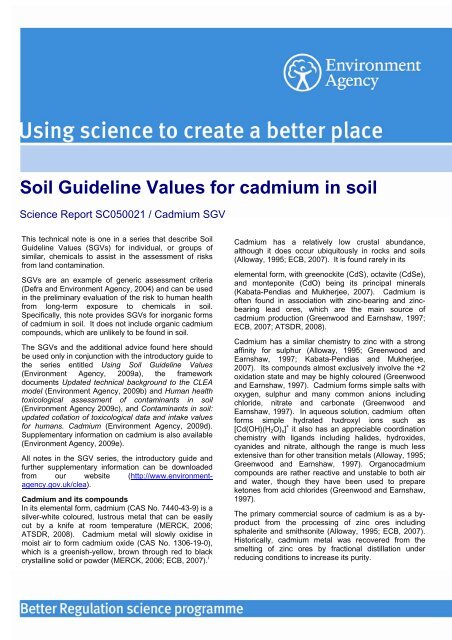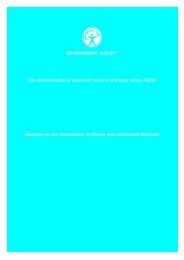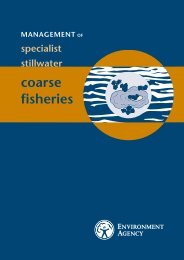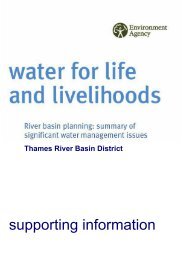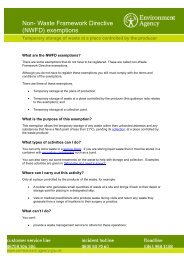Soil Guideline Values for cadmium in soil (PDF, 188 KB)
Soil Guideline Values for cadmium in soil (PDF, 188 KB)
Soil Guideline Values for cadmium in soil (PDF, 188 KB)
Create successful ePaper yourself
Turn your PDF publications into a flip-book with our unique Google optimized e-Paper software.
<strong>Soil</strong> <strong>Guidel<strong>in</strong>e</strong> <strong>Values</strong> <strong>for</strong> <strong>cadmium</strong> <strong>in</strong> <strong>soil</strong><br />
Science Report SC050021 / Cadmium SGV<br />
This technical note is one <strong>in</strong> a series that describe <strong>Soil</strong><br />
<strong>Guidel<strong>in</strong>e</strong> <strong>Values</strong> (SGVs) <strong>for</strong> <strong>in</strong>dividual, or groups of<br />
similar, chemicals to assist <strong>in</strong> the assessment of risks<br />
from land contam<strong>in</strong>ation.<br />
SGVs are an example of generic assessment criteria<br />
(Defra and Environment Agency, 2004) and can be used<br />
<strong>in</strong> the prelim<strong>in</strong>ary evaluation of the risk to human health<br />
from long-term exposure to chemicals <strong>in</strong> <strong>soil</strong>.<br />
Specifically, this note provides SGVs <strong>for</strong> <strong>in</strong>organic <strong>for</strong>ms<br />
of <strong>cadmium</strong> <strong>in</strong> <strong>soil</strong>. It does not <strong>in</strong>clude organic <strong>cadmium</strong><br />
compounds, which are unlikely to be found <strong>in</strong> <strong>soil</strong>.<br />
The SGVs and the additional advice found here should<br />
be used only <strong>in</strong> conjunction with the <strong>in</strong>troductory guide to<br />
the series entitled Us<strong>in</strong>g <strong>Soil</strong> <strong>Guidel<strong>in</strong>e</strong> <strong>Values</strong><br />
(Environment Agency, 2009a), the framework<br />
documents Updated technical background to the CLEA<br />
model (Environment Agency, 2009b) and Human health<br />
toxicological assessment of contam<strong>in</strong>ants <strong>in</strong> <strong>soil</strong><br />
(Environment Agency 2009c), and Contam<strong>in</strong>ants <strong>in</strong> <strong>soil</strong>:<br />
updated collation of toxicological data and <strong>in</strong>take values<br />
<strong>for</strong> humans. Cadmium (Environment Agency, 2009d).<br />
Supplementary <strong>in</strong><strong>for</strong>mation on <strong>cadmium</strong> is also available<br />
(Environment Agency, 2009e).<br />
All notes <strong>in</strong> the SGV series, the <strong>in</strong>troductory guide and<br />
further supplementary <strong>in</strong><strong>for</strong>mation can be downloaded<br />
from our website (http://www.environmentagency.gov.uk/clea).<br />
Cadmium and its compounds<br />
In its elemental <strong>for</strong>m, <strong>cadmium</strong> (CAS No. 7440-43-9) is a<br />
silver-white coloured, lustrous metal that can be easily<br />
cut by a knife at room temperature (MERCK, 2006;<br />
ATSDR, 2008). Cadmium metal will slowly oxidise <strong>in</strong><br />
moist air to <strong>for</strong>m <strong>cadmium</strong> oxide (CAS No. 1306-19-0),<br />
which is a greenish-yellow, brown through red to black<br />
crystall<strong>in</strong>e solid or powder (MERCK, 2006; ECB, 2007). i<br />
Cadmium has a relatively low crustal abundance,<br />
although it does occur ubiquitously <strong>in</strong> rocks and <strong>soil</strong>s<br />
(Alloway, 1995; ECB, 2007). It is found rarely <strong>in</strong> its<br />
elemental <strong>for</strong>m, with greenockite (CdS), octavite (CdSe),<br />
and monteponite (CdO) be<strong>in</strong>g its pr<strong>in</strong>cipal m<strong>in</strong>erals<br />
(Kabata-Pendias and Mukherjee, 2007). Cadmium is<br />
often found <strong>in</strong> association with z<strong>in</strong>c-bear<strong>in</strong>g and z<strong>in</strong>cbear<strong>in</strong>g<br />
lead ores, which are the ma<strong>in</strong> source of<br />
<strong>cadmium</strong> production (Greenwood and Earnshaw, 1997;<br />
ECB, 2007; ATSDR, 2008).<br />
Cadmium has a similar chemistry to z<strong>in</strong>c with a strong<br />
aff<strong>in</strong>ity <strong>for</strong> sulphur (Alloway, 1995; Greenwood and<br />
Earnshaw, 1997; Kabata-Pendias and Mukherjee,<br />
2007). Its compounds almost exclusively <strong>in</strong>volve the +2<br />
oxidation state and may be highly coloured (Greenwood<br />
and Earnshaw, 1997). Cadmium <strong>for</strong>ms simple salts with<br />
oxygen, sulphur and many common anions <strong>in</strong>clud<strong>in</strong>g<br />
chloride, nitrate and carbonate (Greenwood and<br />
Earnshaw, 1997). In aqueous solution, <strong>cadmium</strong> often<br />
<strong>for</strong>ms simple hydrated hxdroxyl ions such as<br />
[Cd(OH)(H2O)x] + it also has an appreciable coord<strong>in</strong>ation<br />
chemistry with ligands <strong>in</strong>clud<strong>in</strong>g halides, hydroxides,<br />
cyanides and nitrate, although the range is much less<br />
extensive than <strong>for</strong> other transition metals (Alloway, 1995;<br />
Greenwood and Earnshaw, 1997). Organo<strong>cadmium</strong><br />
compounds are rather reactive and unstable to both air<br />
and water, though they have been used to prepare<br />
ketones from acid chlorides (Greenwood and Earnshaw,<br />
1997).<br />
The primary commercial source of <strong>cadmium</strong> is as a byproduct<br />
from the process<strong>in</strong>g of z<strong>in</strong>c ores <strong>in</strong>clud<strong>in</strong>g<br />
sphalerite and smithsonite (Alloway, 1995; ECB, 2007).<br />
Historically, <strong>cadmium</strong> metal was recovered from the<br />
smelt<strong>in</strong>g of z<strong>in</strong>c ores by fractional distillation under<br />
reduc<strong>in</strong>g conditions to <strong>in</strong>crease its purity.
The current practice <strong>in</strong> most European countries<br />
<strong>in</strong>volves the electrolytic treatment of <strong>cadmium</strong> sulphate<br />
solution collected dur<strong>in</strong>g the production of z<strong>in</strong>c (ECB,<br />
2007).<br />
Between 2000 and 2002, about 1,100 tonnes per year of<br />
<strong>cadmium</strong> was produced by European countries with a<br />
further 1,700 tonnes per year imported from outside the<br />
European Union (ECB, 2007).<br />
A small but important proportion of <strong>cadmium</strong>, primarily<br />
from batteries, is recycled (ECB, 2007).<br />
Cadmium oxide is an important <strong>in</strong>dustrial chemical,<br />
manufactured by the reaction of metal vapour with air<br />
(ECB, 2007). About 4,500 tonnes per year of <strong>cadmium</strong><br />
oxide were produced across the European Union<br />
between 2000 and 2002 (ECB, 2007).<br />
Cadmium metal, its alloys and compounds have been<br />
used <strong>in</strong> a variety of different <strong>in</strong>dustrial and consumer<br />
products, although most uses are now decl<strong>in</strong><strong>in</strong>g due to<br />
concerns about its toxicity (ATSDR, 2008). Currently,<br />
most <strong>cadmium</strong> is used <strong>in</strong> the production of nickel–<br />
<strong>cadmium</strong> batteries <strong>for</strong> <strong>in</strong>dustrial and commercial use<br />
although alternative products such as lithium ion<br />
batteries have eroded their market share <strong>in</strong> recent years<br />
(ECB, 2007; ATSDR, 2008). Cadmium is also still used<br />
as a semi-conductor and a photo-conductor <strong>in</strong> solar cells<br />
and other electronic devices (ATSDR, 2008).<br />
Cadmium has also been used <strong>in</strong> pigments <strong>for</strong> plastics,<br />
glass and ceramics, as a fungicide, <strong>in</strong> stabilisers <strong>for</strong><br />
plastics <strong>in</strong>clud<strong>in</strong>g PVC, and <strong>in</strong> corrosion-resistant<br />
coat<strong>in</strong>gs on steel and other non-ferrous metals; it has<br />
other m<strong>in</strong>or applications <strong>for</strong> photography, photocopy<strong>in</strong>g,<br />
dye<strong>in</strong>g, calico pr<strong>in</strong>t<strong>in</strong>g, vacuum tube manufacture,<br />
galvanoplasty, lubricants, ice-nucleation agents, and <strong>in</strong><br />
the manufacture of special mirrors (Alloway, 1995; ECB,<br />
2007; Kabata-Pendias and Mukherjee, 2007; ATSDR,<br />
2008).<br />
Accord<strong>in</strong>g to a mass balance analysis of production,<br />
imports and exports <strong>for</strong> the period 2000 to 2002, the<br />
European Union used around 2,300 tonnes of <strong>cadmium</strong><br />
with some 80 per cent used to make Ni–Cd batteries,<br />
and the rema<strong>in</strong><strong>in</strong>g 20 per cent used <strong>for</strong> pigments,<br />
stabilisers, and alloys/metal plat<strong>in</strong>g (ECB, 2007).<br />
Potential harm to human health<br />
The pr<strong>in</strong>ciples beh<strong>in</strong>d the selection of Health Criteria<br />
<strong>Values</strong> (HCVs), and the def<strong>in</strong>ition of concepts and terms<br />
used, are outl<strong>in</strong>ed <strong>in</strong> Human health toxicological<br />
assessment of contam<strong>in</strong>ants <strong>in</strong> <strong>soil</strong> (Environment<br />
Agency, 2009c). Specific <strong>in</strong><strong>for</strong>mation on the toxicity of<br />
<strong>cadmium</strong> and its compounds is reviewed <strong>in</strong><br />
Contam<strong>in</strong>ants <strong>in</strong> <strong>soil</strong>: updated collation of toxicological<br />
data and <strong>in</strong>take values <strong>for</strong> humans. Cadmium<br />
(Environment Agency, 2009d) and only a brief summary<br />
is presented here.<br />
Follow<strong>in</strong>g long-term exposure to <strong>cadmium</strong>, the ma<strong>in</strong><br />
health concerns are its toxicity to the kidney and bones,<br />
aris<strong>in</strong>g via <strong>in</strong>gestion and <strong>in</strong>halation, and its lung<br />
carc<strong>in</strong>ogenicity seen <strong>in</strong> exposed workers follow<strong>in</strong>g<br />
<strong>in</strong>halation (Environment Agency, 2009d).<br />
Over a period of time, <strong>cadmium</strong> accumulates <strong>in</strong> the<br />
kidney and, if the organ concentration exceeds a critical<br />
threshold, the tubule cells become damaged and renal<br />
function impaired (Environment Agency, 2009d).<br />
This <strong>cadmium</strong> build-up also affects vitam<strong>in</strong> D<br />
metabolism, disturb<strong>in</strong>g the calcium balance with<strong>in</strong> the<br />
body, which may lead to a decrease <strong>in</strong> the m<strong>in</strong>eral<br />
content with<strong>in</strong> the bones, result<strong>in</strong>g <strong>in</strong> osteoporosis and<br />
osteomalacia (Environment Agency, 2009d).<br />
The oral tolerable daily <strong>in</strong>take (TDIoral), which is based<br />
on an evaluation by the European Food Safety Authority<br />
(EFSA), is protective of renal and bone health effects<br />
(Environment Agency, 2009d).<br />
The <strong>in</strong>halation tolerable daily <strong>in</strong>take (TDI<strong>in</strong>h), which is<br />
based on the proposal of a European Commission<br />
Table 1<br />
Recommended Health Criteria <strong>Values</strong> and estimated<br />
background adult <strong>in</strong>takes <strong>for</strong> <strong>in</strong>organic compounds of<br />
<strong>cadmium</strong> (Environment Agency, 2009d)<br />
Parameter Cadmium<br />
TDIoral, µg kg -1 bw day -1 0.36<br />
MDIoral, µg day -1 13.4<br />
TDI<strong>in</strong>h, µg kg -1 bw day -1 0.0014<br />
MDI<strong>in</strong>h, µg day -1 0.02<br />
Notes<br />
bw = bodyweight<br />
TDI = tolerable daily <strong>in</strong>take<br />
MDI = mean daily <strong>in</strong>take<br />
Work<strong>in</strong>g Group, is aga<strong>in</strong> protective of renal health<br />
effects. Exposure at this level is expected to pose a<br />
m<strong>in</strong>imal risk of lung cancer (Environment Agency,<br />
2009d).<br />
Health Criteria <strong>Values</strong> (HCVs) <strong>for</strong> <strong>cadmium</strong> and its<br />
<strong>in</strong>organic compounds are summarised <strong>in</strong> Table 1.<br />
The adult oral mean daily <strong>in</strong>take (MDIoral) <strong>for</strong> <strong>cadmium</strong> is<br />
estimated at 13.4 µg day -1 . The adult <strong>in</strong>halation mean<br />
daily <strong>in</strong>take (MDI<strong>in</strong>h) is approximately 0.02 µg day -1<br />
(Environment Agency, 2009d).<br />
The effects of dermal exposure to <strong>cadmium</strong> are not<br />
expected to be significant and no expert group<br />
derivations of HCVs <strong>for</strong> dermal exposure were identified<br />
(Environment Agency, 2009d). Dermal absorption<br />
appears to be lower than oral absorption and, on this<br />
basis, it would seem reasonable to assume that the oral<br />
TDI <strong>for</strong> deriv<strong>in</strong>g SGVs could be used <strong>for</strong> an <strong>in</strong>itial<br />
conservative dermal risk assessment, <strong>in</strong> l<strong>in</strong>e with<br />
Environment Agency (2009c).<br />
Oral, dermal and <strong>in</strong>halation exposures contribute to the<br />
same systemic effects on the kidney and bone;<br />
there<strong>for</strong>e, this should also be considered <strong>in</strong> a risk<br />
assessment.
Exposure assessment<br />
Occurrence <strong>in</strong> <strong>soil</strong><br />
Cadmium occurs naturally <strong>in</strong> <strong>soil</strong>s as a result of the<br />
weather<strong>in</strong>g of the parent rock (Alloway, 1995).<br />
Sedimentary rocks have the greatest range of <strong>cadmium</strong><br />
concentrations with the highest values found <strong>in</strong><br />
sedimentary phosphate deposits and black shales<br />
(Alloway, 1995). Although most natural <strong>soil</strong>s conta<strong>in</strong><br />
less than 1 mg kg -1 <strong>cadmium</strong> from the weather<strong>in</strong>g of<br />
parent materials, those developed on black shales and<br />
those associated with m<strong>in</strong>eralised deposits can have<br />
much higher levels (Alloway, 1995).<br />
Anthropogenic sources of <strong>cadmium</strong> are much more<br />
significant than natural emissions and account <strong>for</strong> its<br />
ubiquitous presence <strong>in</strong> <strong>soil</strong> (Alloway, 1995; ECB, 2007;<br />
ATSDR, 2008). Cadmium is a trace element <strong>in</strong><br />
phosphatic fertilisers, which have been applied<br />
extensively to arable and pasture land <strong>in</strong> the UK <strong>for</strong><br />
decades (Alloway, 1995). ECB (2007) reported that<br />
current fertilisers conta<strong>in</strong> around 79 mg of <strong>cadmium</strong> per<br />
kilogram of phosphorus. Based on the use of fertilisers<br />
<strong>in</strong> the 1980s and early 1990s, Alloway (1995) estimated<br />
that around 4.3 g of <strong>cadmium</strong> per hectare per year has<br />
been added to agricultural <strong>soil</strong>s <strong>in</strong> the UK. Across the<br />
European Union, 231 tonnes of <strong>cadmium</strong> are added to<br />
agricultural <strong>soil</strong>s each year from fertiliser use (EC,<br />
2007).<br />
Atmospheric deposition is also an important source of<br />
<strong>cadmium</strong> pollution (Alloway, 1995; ECB, 2007; ATSDR,<br />
2008). The major sources of atmospheric emissions are<br />
non-ferrous metal production, fossil fuel combustion,<br />
waste <strong>in</strong>c<strong>in</strong>eration, and iron and steel production<br />
(Alloway, 1995; ATSDR, 2008). A representative<br />
deposition rate to agricultural land across the European<br />
Union has been estimated to be 3 g of <strong>cadmium</strong> per<br />
hectare per year (Alloway, 1995; Kabata-Pendias and<br />
Mukherjee, 2007).<br />
Other sources of <strong>cadmium</strong> contam<strong>in</strong>ation <strong>in</strong>clude the<br />
application of sewage sludge, and metalliferous m<strong>in</strong><strong>in</strong>g<br />
and smelt<strong>in</strong>g of z<strong>in</strong>c and sulphide ores (Alloway, 1995;<br />
ECB, 2007; ATSDR, 2008). Although these are<br />
relatively small contributors to global <strong>cadmium</strong><br />
pollution, 1 these sources can be regionally and locally<br />
highly significant. For example, the <strong>soil</strong>s of a village <strong>in</strong><br />
southwest England were found to be highly<br />
contam<strong>in</strong>ated with z<strong>in</strong>c, lead and <strong>cadmium</strong> as a result of<br />
the local m<strong>in</strong><strong>in</strong>g of z<strong>in</strong>c dur<strong>in</strong>g the 18th and 19th<br />
centuries (Alloway et al., 1988).<br />
The UK <strong>Soil</strong> and Herbage Survey (UK SHS) is a<br />
comprehensive survey of the concentrations of major<br />
contam<strong>in</strong>ants <strong>in</strong> <strong>soil</strong>s and herbage across the UK. The<br />
UK SHS found total <strong>cadmium</strong> concentrations <strong>in</strong> the<br />
range 0.1 to 1.8 mg kg -1 dry weight (DW) <strong>for</strong> rural <strong>soil</strong>s,<br />
with a mean of 0.39 mg kg -1 (Environment Agency,<br />
2007). This is broadly consistent with the mean value of<br />
0.49 mg kg -1 DW found by Spurgeon et al. (2008), who<br />
collected more than 1,000 samples from across the UK<br />
1 It is estimated that around 13.6 tonnes per year of <strong>cadmium</strong><br />
are added to <strong>soil</strong>s from the application of sewage sludge to<br />
land (ECB, 2007).<br />
from predom<strong>in</strong>ately rural locations. A similar distribution<br />
was found <strong>in</strong> the UK SHS <strong>for</strong> urban <strong>soil</strong>s, with a range of<br />
0.1 to 2.39 mg kg -1 DW and a mean of 0.44 mg kg -1<br />
(Environment Agency, 2007).<br />
The difference <strong>in</strong> <strong>cadmium</strong> <strong>soil</strong> concentrations across<br />
the UK has been attributed to a probable higher<br />
prevalence and closer proximity to activities generat<strong>in</strong>g<br />
<strong>cadmium</strong> contam<strong>in</strong>ation (e.g. lead and z<strong>in</strong>c m<strong>in</strong><strong>in</strong>g or<br />
associated smelt<strong>in</strong>g) rather than the more widespread<br />
use of phosphate fertilisers or use of sewage sludge on<br />
land (Environment Agency, 2007).<br />
Behaviour <strong>in</strong> the <strong>soil</strong> environment<br />
Recommended values <strong>for</strong> chemical data used <strong>in</strong> the<br />
exposure modell<strong>in</strong>g of <strong>cadmium</strong> and its <strong>in</strong>organic<br />
compounds are shown <strong>in</strong> Table 7. Further <strong>in</strong><strong>for</strong>mation<br />
about the selection of chemical properties and the<br />
derivation of the <strong>soil</strong>-to-plant concentration factors <strong>for</strong><br />
<strong>in</strong>organic compounds of <strong>cadmium</strong> can be found <strong>in</strong><br />
Supplementary <strong>in</strong><strong>for</strong>mation <strong>for</strong> the derivation of SGV <strong>for</strong><br />
<strong>cadmium</strong> (Environment Agency, 2009e).<br />
Several studies have observed that <strong>cadmium</strong><br />
concentrates <strong>in</strong> the surface horizon, most likely due to<br />
the comb<strong>in</strong>ation of the sources of pollution (primarily<br />
fertiliser application and atmospheric deposition) and the<br />
higher near-surface levels of organic matter to which it<br />
readily b<strong>in</strong>ds (Alloway, 1995; ATSDR, 2008).<br />
The <strong>soil</strong> chemistry of <strong>cadmium</strong> is based on the divalent<br />
cation (Cd 2+ ). The hydrated free cation is the ma<strong>in</strong><br />
species of <strong>cadmium</strong> <strong>in</strong> <strong>soil</strong> solution, but it is also known<br />
to <strong>for</strong>m complex ions with chloride (CdCl + -<br />
, CdCl3 ,<br />
2- + - 2-<br />
CdCl4 ), hydroxyl groups [CdOH , Cd(OH)3 , Cd(OH)4 ],<br />
and bicarbonate, as well as neutral soluble species such<br />
as <strong>cadmium</strong> sulphate (CdSO4) and <strong>cadmium</strong> chloride<br />
(CdCl2) Alloway, 1995; Kabata-Pendias and Mukherjee,<br />
2007). Soluble and <strong>in</strong>soluble complexes with organic<br />
matter can also be important, although <strong>cadmium</strong> <strong>for</strong>ms<br />
less stable complexes with humic and fulvic acids than<br />
those <strong>for</strong>med by copper and lead (Alloway, 1995;<br />
Kabata-Pendias and Mukherjee, 2007).<br />
Surface adsorption processes rather than precipitation<br />
appear to control the distribution of <strong>cadmium</strong> between<br />
<strong>soil</strong> solution and <strong>soil</strong>-bound <strong>for</strong>ms at the concentrations<br />
relevant to most polluted <strong>soil</strong>s (Alloway, 1995). At<br />
extremely high <strong>cadmium</strong> concentrations, however, the<br />
precipitation of phosphates and carbonates could be<br />
expected (Alloway, 1995). Under anaerobic conditions,<br />
<strong>cadmium</strong> <strong>in</strong> <strong>soil</strong> solution may be controlled by the<br />
<strong>for</strong>mation of <strong>in</strong>soluble sulphides (Kabata-Pendias and<br />
Mukherjee, 2007).<br />
Adsorption of <strong>cadmium</strong> by <strong>soil</strong> depends strongly on pH,<br />
with its mobility decreas<strong>in</strong>g with <strong>in</strong>creas<strong>in</strong>g alkal<strong>in</strong>ity<br />
(Anderson and Christensen, 1988; Alloway, 1995; Holm<br />
et al., 2003). <strong>Soil</strong> organic matter (SOM) is also an<br />
important factor (Holm et al., 2003; Kabata-Pendias and<br />
Mukherjee, 2007). Sauve et al. (2000) found that the<br />
variability <strong>in</strong> <strong>soil</strong>–water partition coefficients (Kd) <strong>for</strong><br />
<strong>cadmium</strong> collected from over 70 different studies was<br />
largely expla<strong>in</strong>ed by differences <strong>in</strong> <strong>soil</strong> pH, <strong>soil</strong> organic<br />
matter content and total <strong>cadmium</strong> concentration. Strobel<br />
et al. (2005) observed that anthropogenic <strong>cadmium</strong> may
e more readily released from <strong>soil</strong> than pedogenic<br />
<strong>cadmium</strong> associated with <strong>soil</strong> m<strong>in</strong>erals such as apatite.<br />
Organic matter may be better at keep<strong>in</strong>g <strong>cadmium</strong><br />
unavailable than specific and non-specific adsorption to<br />
<strong>in</strong>organic m<strong>in</strong>eral surfaces (Holm et al., 2003; ATSDR,<br />
2008). Strobel et al. (2005) noted that the addition of<br />
dissolved organic carbon did not directly enhance the<br />
release of <strong>cadmium</strong> from a Danish agricultural <strong>soil</strong> but<br />
assisted <strong>in</strong> decreas<strong>in</strong>g the <strong>soil</strong> pH, which resulted <strong>in</strong><br />
more rapid <strong>cadmium</strong> leach<strong>in</strong>g. A secondary factor<br />
controll<strong>in</strong>g the mobility of <strong>cadmium</strong> is the presence of<br />
iron and manganese hydrous oxides, and organic<br />
matter–iron complexes (Alloway, 1995; Holm et al.,<br />
2003; Kabata-Pendias and Mukherjee, 2007).<br />
Plant species and cultivars differ widely <strong>in</strong> their ability to<br />
uptake, accumulate and tolerate heavy metals <strong>in</strong>clud<strong>in</strong>g<br />
<strong>cadmium</strong> (Alloway, 1995; Environment Agency, 2009e).<br />
Lettuce, sp<strong>in</strong>ach, celery and cabbage are reported to<br />
accumulate <strong>cadmium</strong> while potatoes, french beans and<br />
peas take up only small amounts (Alloway, 1995).<br />
Several studies have concluded that <strong>soil</strong> pH is the most<br />
important factor controll<strong>in</strong>g plant uptake and that this is<br />
l<strong>in</strong>ked to the concentration of <strong>cadmium</strong> <strong>in</strong> <strong>soil</strong> solution<br />
(Kabata-Pendias and Pendias, 2001; ATSDR, 2008;<br />
Environment Agency, 2009e). Lim<strong>in</strong>g <strong>soil</strong> to <strong>in</strong>crease<br />
pH to 7 and above has been shown to reduce the<br />
mobility and plant availability of <strong>cadmium</strong> <strong>in</strong> different<br />
<strong>soil</strong>s (Alloway, 1995; ATSDR, 2008).<br />
Plants have no metabolic requirement <strong>for</strong> <strong>cadmium</strong> and<br />
the symptoms of its toxicity <strong>in</strong>clude stunted growth and<br />
chlorosis (Kabata-Pendias and Mukherjee, 2007). The<br />
Table 2<br />
The <strong>Soil</strong> <strong>Guidel<strong>in</strong>e</strong> <strong>Values</strong> <strong>for</strong> <strong>cadmium</strong> presented <strong>in</strong> this<br />
table should only be used <strong>in</strong> conjunction with the <strong>in</strong><strong>for</strong>mation<br />
conta<strong>in</strong>ed <strong>in</strong> this brief<strong>in</strong>g note and with an understand<strong>in</strong>g of<br />
the exposure and toxicological assumptions conta<strong>in</strong>ed <strong>in</strong><br />
Updated technical background to the CLEA model<br />
(Environment Agency, 2009b) Human health toxicological<br />
assessment of contam<strong>in</strong>ants <strong>in</strong> <strong>soil</strong> (Environment Agency,<br />
2009c) and Contam<strong>in</strong>ants <strong>in</strong> <strong>soil</strong>: updated collation of<br />
toxicological data and <strong>in</strong>take values <strong>for</strong> humans. Cadmium<br />
(Environment Agency, 2009d).<br />
<strong>Soil</strong> <strong>Guidel<strong>in</strong>e</strong> Value<br />
(mg kg -1 DW) 1,2,3,4<br />
Land use<br />
Cadmium<br />
Residential 10<br />
Allotment 1.8<br />
Commercial 230<br />
1<br />
Notes Figures are rounded to one or two<br />
significant figures.<br />
2<br />
Based on a sandy loam <strong>soil</strong> as def<strong>in</strong>ed <strong>in</strong><br />
Environment Agency (2009b) and 6% SOM.<br />
3<br />
Based on lifetime exposure via oral, dermal<br />
and <strong>in</strong>halation pathways.<br />
4<br />
In apply<strong>in</strong>g the rules <strong>for</strong> non-<strong>soil</strong><br />
background to the SGV, the background<br />
ADE is limited to be<strong>in</strong>g no larger than the<br />
contribution from the relevant <strong>soil</strong> ADE.<br />
phytotoxicity of <strong>cadmium</strong> is due to its <strong>in</strong>terference with<br />
the normal metabolism of some micronutrients, its<br />
<strong>in</strong>hibitory effect on photosynthesis, its ability to disturb<br />
the transpiration and fixation of carbon dioxide, and its<br />
effect on the permeability of cell membranes (Kabata-<br />
Pendias and Pendias, 2001). The critical concentration<br />
<strong>for</strong> the phytotoxicity of <strong>cadmium</strong> has been reported <strong>in</strong><br />
the range 5–20 mg kg -1 fresh weight (FW) <strong>in</strong> plant<br />
tissues depend<strong>in</strong>g on plant species (Kabata-Pendias<br />
and Pendias, 2001).<br />
Dermal absorption of <strong>cadmium</strong> and its <strong>in</strong>organic<br />
compounds from <strong>soil</strong> is not expected to be significant.<br />
USEPA (2004) recommended a dermal absorption<br />
fraction (ABSd) of 0.001 <strong>for</strong> <strong>cadmium</strong> and this value has<br />
been used <strong>in</strong> the derivation of SGVs.<br />
Several recent studies have recognised the potential<br />
importance of house dust as a route <strong>for</strong> exposure to<br />
<strong>cadmium</strong> (Feng and Barratt, 1994; Hogervorst et al.,<br />
2007). However, there are <strong>in</strong>sufficient data <strong>in</strong> the<br />
literature to provide a generalised <strong>cadmium</strong> <strong>soil</strong>-to-dust<br />
transport factor. In the absence of a contam<strong>in</strong>ant<br />
specific <strong>soil</strong>-to-dust transport factor, the default value of<br />
0.5 g g -1 DW has been used (Environment Agency,<br />
2009b).<br />
In an <strong>in</strong>vestigation <strong>in</strong> northern Belgium, Hogervorst et al.<br />
(2007) looked at the relationship between adult<br />
exposure and house dust concentrations <strong>in</strong> an area that<br />
had been contam<strong>in</strong>ated by z<strong>in</strong>c smelt<strong>in</strong>g. The <strong>cadmium</strong><br />
load<strong>in</strong>g rate <strong>in</strong> house dust was found to be significantly<br />
correlated to the <strong>cadmium</strong> concentration <strong>in</strong> <strong>soil</strong> and the<br />
distance from the dwell<strong>in</strong>g to the z<strong>in</strong>c smelters.<br />
However, the ma<strong>in</strong> f<strong>in</strong>d<strong>in</strong>g of the study was that the<br />
load<strong>in</strong>g rates of <strong>cadmium</strong> <strong>in</strong> house dust were associated<br />
with the biomarkers of <strong>in</strong>ternal exposure and that this<br />
association was <strong>in</strong>dependent of an <strong>in</strong>dex to account <strong>for</strong><br />
exposure via consumption of vegetables (Hogervorst et<br />
al., 2007). Feng and Barratt (1994) studied three<br />
houses and two offices <strong>in</strong> the UK; they found that<br />
<strong>cadmium</strong> concentration <strong>in</strong>creased with decreas<strong>in</strong>g<br />
particle size and was correlated to the house age<br />
although no relationship with <strong>soil</strong> concentration was<br />
<strong>in</strong>vestigated.<br />
<strong>Soil</strong> <strong>Guidel<strong>in</strong>e</strong> <strong>Values</strong><br />
<strong>Soil</strong> <strong>Guidel<strong>in</strong>e</strong> <strong>Values</strong> (SGVs) <strong>for</strong> <strong>cadmium</strong> are<br />
presented accord<strong>in</strong>g to land use <strong>in</strong> Table 2. The SGVs<br />
apply only to <strong>cadmium</strong> and its <strong>in</strong>organic compounds.<br />
For residential and allotment land uses, SGVs are based<br />
on estimates representative of lifetime exposure.<br />
Although young children are generally more likely to<br />
have higher exposures to <strong>soil</strong> contam<strong>in</strong>ants, the renal<br />
toxicity of <strong>cadmium</strong> – and the derivation of the TDIoral<br />
and TDI<strong>in</strong>h – are based on considerations of the kidney<br />
burden accumulated over 50 years or so (Environment<br />
Agency, 2009e). It is there<strong>for</strong>e reasonable to consider<br />
exposure not only <strong>in</strong> childhood but averaged over a<br />
longer time period.<br />
The residential and allotment land use scenarios<br />
presented <strong>in</strong> Updated technical background to the CLEA<br />
model (Environment Agency, 2009b) <strong>in</strong>clude
ecommended values <strong>for</strong> estimat<strong>in</strong>g exposure <strong>for</strong> young<br />
children only (age classes 1–6). However, the report<br />
conta<strong>in</strong>s additional <strong>in</strong><strong>for</strong>mation on receptor and<br />
exposure characteristics that are appropriate <strong>for</strong><br />
estimat<strong>in</strong>g lifetime exposure (age classes 1–18) <strong>for</strong><br />
these standard land use scenarios. This additional<br />
<strong>in</strong><strong>for</strong>mation has been used to estimate lifetime exposure<br />
characteristics <strong>for</strong> the derivation of the SGVs <strong>in</strong> this<br />
technical note; these exposure characteristics are<br />
summarised <strong>in</strong> Tables 3 and 4. Where exposure<br />
characteristics <strong>for</strong> older children are not <strong>in</strong> Environment<br />
Agency (2009b), often because of a lack of underly<strong>in</strong>g<br />
data, it has been assumed that:<br />
• <strong>for</strong> children up to the age of 12 (age classes 7–<br />
12) the data <strong>for</strong> young children are most<br />
applicable;<br />
• <strong>for</strong> children aged 12–16 (age classes 13–16)<br />
behaviour will be similar to adults.<br />
Table 5 presents default <strong>in</strong>halation rates <strong>for</strong> all age<br />
classes accord<strong>in</strong>g to age and sex <strong>for</strong> the allotment land<br />
use based on short-term exposure. This table extends<br />
the data presented <strong>in</strong> Table 4.15 <strong>in</strong> Environment Agency<br />
(2009b) and has been calculated us<strong>in</strong>g the same<br />
methodology (Environment Agency, 2009b; Lordo et al.,<br />
2006).<br />
Table 3<br />
Default exposure characteristics <strong>for</strong> lifetime exposure <strong>for</strong> the standard residential land use<br />
It is important to note that <strong>for</strong> the most significant<br />
exposure pathway <strong>for</strong> <strong>cadmium</strong> (i.e. the consumption of<br />
homegrown produce) the receptor data have been<br />
robustly estimated from UK data <strong>for</strong> all age classes<br />
(Environment Agency, 2009b).<br />
Analytical limits of detection 2 <strong>for</strong> total <strong>cadmium</strong><br />
concentration <strong>in</strong> <strong>soil</strong> depend on the analytical technique<br />
used and range from 0.1 to 0.3 mg kg -1 DW with limits of<br />
quantification 3 rang<strong>in</strong>g from 0.5 to 1.5 mg kg -1 DW.<br />
Limits of detection and quantification can vary due to the<br />
sample matrix and the range, sensitivity, set-up of the<br />
<strong>in</strong>strumentation be<strong>in</strong>g used. MCERTS 4 accredited<br />
analytical methods <strong>for</strong> test<strong>in</strong>g <strong>for</strong> total <strong>cadmium</strong> <strong>in</strong> <strong>soil</strong><br />
are available.<br />
Exposure frequencies (day year -1 )<br />
Dermal Inhalation<br />
Occupancy periods<br />
(hours day -1 )<br />
<strong>Soil</strong>-to-sk<strong>in</strong> AF<br />
(mg cm -2 Age<br />
class <strong>Soil</strong> / dust<br />
<strong>in</strong>gestion<br />
Homegrown<br />
Indoor Outdoor Indoor Outdoor<br />
produce<br />
Garden Indoor<br />
)<br />
Indoor Outdoor<br />
<strong>Soil</strong> and dust<br />
<strong>in</strong>gestion rates<br />
(g day -1 )<br />
1 180 180 180 180 365 365 1 23 0.06 1 0.1<br />
2 365 365 365 365 365 365 1 23 0.06 1 0.1<br />
3 365 365 365 365 365 365 1 23 0.06 1 0.1<br />
4 365 365 365 365 365 365 1 23 0.06 1 0.1<br />
5 365 365 365 365 365 365 1 19 0.06 1 0.1<br />
6 365 365 365 365 365 365 1 19 0.06 1 0.1<br />
7 365 365 365 365 365 365 1 19 0.06 1 0.1<br />
8 365 365 365 365 365 365 1 19 0.06 1 0.1<br />
9 365 365 365 365 365 365 1 19 0.06 1 0.1<br />
10 365 365 365 365 365 365 1 19 0.06 1 0.1<br />
11 365 365 365 365 365 365 1 19 0.06 1 0.1<br />
12 365 365 365 365 365 365 1 19 0.06 1 0.1<br />
13 365 365 365 365 365 365 1 15 0.06 0.3 0.05<br />
14 365 365 365 365 365 365 1 15 0.06 0.3 0.05<br />
15 365 365 365 365 365 365 1 15 0.06 0.3 0.05<br />
16 365 365 365 365 365 365 1 15 0.06 0.3 0.05<br />
17 365 365 365 365 365 365 1 16 0.06 0.3 0.05<br />
18 365 365 365 365 365 365 1 16 0.06 0.3 0.05<br />
2<br />
The amount of a substance that can be detected, but not<br />
quantitatively measured<br />
3<br />
The amount present of a substance that can be quantitatively<br />
measured<br />
4<br />
Environment Agency’s Monitor<strong>in</strong>g Certification Scheme
Table 4<br />
Default exposure characteristics <strong>for</strong> lifetime exposure <strong>for</strong> the standard allotment land use<br />
Age<br />
class<br />
Exposure frequencies (day year -1 )<br />
Dermal Inhalation<br />
Table 5<br />
This table presents default <strong>in</strong>halation rates accord<strong>in</strong>g to<br />
age and sex <strong>for</strong> the allotment land use, based on shortterm<br />
exposure. It extends <strong>in</strong><strong>for</strong>mation found <strong>in</strong> Table<br />
4.15 (Environment Agency, 2009b) to all age classes.<br />
Inhalation rate 1 (m 3 day -1 Age class<br />
)<br />
Female Male<br />
1 10.3 12.5<br />
2 18.8 19.7<br />
3 20.7 20.4<br />
4 19.1 20.6<br />
5 21.3 22.9<br />
6<br />
7<br />
24.9 25.5<br />
2 8<br />
17.6 18.5<br />
2 9<br />
20.2 20.5<br />
2 10<br />
21.8 22.7<br />
2 11<br />
25.0 26.8<br />
2 12<br />
28.4 28.7<br />
2 13<br />
19.8 21.2<br />
2 14<br />
22.7 23.3<br />
2 15<br />
24.5 26.5<br />
2 16<br />
27.2 31.2<br />
2 17<br />
28.3 32.4<br />
3 18<br />
27.4 35.7<br />
3 25.4 34.5<br />
Notes<br />
1<br />
Assum<strong>in</strong>g an hourly rate <strong>for</strong> 24 hours.<br />
2<br />
Assumes the balance between light and<br />
moderate activity is half-and-half.<br />
3<br />
Assumes an adult spends two-thirds of their<br />
time undertak<strong>in</strong>g moderate <strong>in</strong>tensity activities<br />
and one-third light activities.<br />
Occupancy<br />
period<br />
(hours day -1 )<br />
<strong>Soil</strong>-to-sk<strong>in</strong> AF<br />
(mg cm -2 )<br />
<strong>Soil</strong> and dust<br />
<strong>in</strong>gestion rates<br />
(g day -1 )<br />
<strong>Soil</strong> / dust<br />
<strong>in</strong>gestion<br />
Homegrown<br />
produce<br />
Indoor Outdoor Indoor Outdoor Allotment Outdoor<br />
1 25 180 0 25 0 25 3 1 0.1<br />
2 130 365 0 130 0 130 3 1 0.1<br />
3 130 365 0 130 0 130 3 1 0.1<br />
4 130 365 0 130 0 130 3 1 0.1<br />
5 65 365 0 65 0 65 3 1 0.1<br />
6 65 365 0 65 0 65 3 1 0.1<br />
7 65 365 0 65 0 65 3 1 0.1<br />
8 65 365 0 65 0 65 3 1 0.1<br />
9 65 365 0 65 0 65 3 1 0.1<br />
10 65 365 0 65 0 65 3 1 0.1<br />
11 65 365 0 65 0 65 3 1 0.1<br />
12 65 365 0 65 0 65 3 1 0.1<br />
13 25 365 0 25 0 25 3 0.3 0.05<br />
14 25 365 0 25 0 25 3 0.3 0.05<br />
15 25 365 0 25 0 25 3 0.3 0.05<br />
16 25 365 0 25 0 25 3 0.3 0.05<br />
17 258 365 0 258 0 258 3 0.3 0.05<br />
18 258 365 0 258 0 258 3 0.3 0.05<br />
Further risk evaluation<br />
The SGVs <strong>for</strong> <strong>cadmium</strong> are based on a consideration of<br />
the total systemic exposure via the oral, dermal and<br />
<strong>in</strong>halation routes. Dermal absorption of <strong>cadmium</strong><br />
appears to be low compared with oral absorption and<br />
there<strong>for</strong>e, <strong>in</strong> the absence of specific toxicity data <strong>for</strong> the<br />
dermal pathway, it is reasonable to compare dermal<br />
exposure with the TDIoral.<br />
Table 6 presents the estimated contribution via each<br />
exposure pathway to total exposure at a <strong>soil</strong><br />
concentration equal to the SGV <strong>for</strong> all land use<br />
scenarios. The ratios of oral/dermal and <strong>in</strong>halation<br />
exposure to the relevant TDI at a <strong>soil</strong> concentration<br />
equal to the SGV are also reported. The data show that:<br />
• consumption of homegrown produce and attached<br />
<strong>soil</strong> makes the greatest contribution to total<br />
exposure <strong>for</strong> the residential and allotment land use<br />
scenarios and is the risk driv<strong>in</strong>g pathway;<br />
• <strong>soil</strong> <strong>in</strong>gestion makes the greatest contribution to total<br />
exposure <strong>for</strong> the commercial land use scenario and<br />
is one of the risk driv<strong>in</strong>g pathways;<br />
• <strong>in</strong>halation of <strong>in</strong>door dust makes a negligible<br />
contribution to total exposure but is an important risk<br />
driver <strong>for</strong> the commercial land use because of the<br />
significantly lower potential threshold of toxicity <strong>for</strong><br />
<strong>cadmium</strong> via the non-oral route (the TDI<strong>in</strong>h is about<br />
250 times lower than the TDIoral);<br />
• background exposure is a significant contributor to<br />
total exposure <strong>for</strong> all land use scenarios.
Exposure to <strong>cadmium</strong> from non-<strong>soil</strong> sources <strong>in</strong>clud<strong>in</strong>g<br />
the diet and ambient air is high relative to the TDIoral and<br />
TDI<strong>in</strong>h respectively, and <strong>for</strong> young children there is the<br />
possibility that non-<strong>soil</strong> exposure exceeds 50 per cent of<br />
the relevant TDI (Environment Agency, 2009d). In<br />
deriv<strong>in</strong>g the SGV, a m<strong>in</strong>imum proportion of 50 per cent<br />
of the TDI is reserved <strong>for</strong> exposure from <strong>soil</strong> sources<br />
and thus at representative <strong>soil</strong> concentrations greater<br />
than the SGV, the total exposure from <strong>soil</strong> and non-<strong>soil</strong><br />
sources will exceed the TDI (Environment Agency,<br />
2009b).<br />
Young children tend to have the highest potential<br />
exposures to contam<strong>in</strong>ants <strong>in</strong> <strong>soil</strong>; this comb<strong>in</strong>ed with<br />
their lower body weights compared with adults means<br />
they are often at greatest risk of exposure exceed<strong>in</strong>g the<br />
TDIoral or TDI<strong>in</strong>h (Environment Agency, 2009b).<br />
Averag<strong>in</strong>g exposure over a lifetime typically results <strong>in</strong><br />
the exposures <strong>for</strong> young children exceed<strong>in</strong>g the relevant<br />
TDI, even though overall exposure over the lifetime does<br />
not (Environment Agency, 2009b). In evaluat<strong>in</strong>g the<br />
impact of apply<strong>in</strong>g lifetime exposure to the derivation of<br />
the SGV <strong>for</strong> <strong>cadmium</strong>, the total average exposure <strong>for</strong><br />
young children (from <strong>soil</strong> and non-<strong>soil</strong> sources) over age<br />
classes 1–6 has been estimated to be about two and a<br />
half times the TDIoral. This is not anticipated to be of<br />
significant toxicological concern (Environment Agency,<br />
2009d). However, long-term exposure to levels <strong>in</strong><br />
excess of either the TDIoral or the TDI<strong>in</strong>h might be<br />
associated with an <strong>in</strong>crease <strong>in</strong> kidney disease <strong>in</strong> a<br />
proportion of those exposed.<br />
The dom<strong>in</strong>ant exposure pathway <strong>for</strong> the residential and<br />
allotment land use scenarios is through the consumption<br />
of homegrown produce <strong>in</strong>clud<strong>in</strong>g fruit and vegetables<br />
(see Table 6). Based on the residential SGV, estimated<br />
levels of <strong>cadmium</strong> <strong>in</strong> some produce categories (notably<br />
green vegetables and herbaceous fruits) may exceed<br />
the maximum permissable levels <strong>for</strong> foodstuffs to be<br />
placed on the market under current UK regulations (EC,<br />
2006; TSO, 2007). However, it is assumed <strong>in</strong> the SGV<br />
derivation that such produce is not sold and the amounts<br />
eaten by the householder and their family represent only<br />
a small proportion of their overall diet.<br />
At a <strong>soil</strong> concentration equal to the allotment SGV,<br />
estimated levels of <strong>cadmium</strong> across all produce<br />
categories are below the maximum permissible levels<br />
allowed <strong>in</strong> food placed on the market (EC, 2006; TSO,<br />
2007). However, the SGV <strong>for</strong> the allotment land use is<br />
close to the analytical limits <strong>for</strong> quantification and<br />
there<strong>for</strong>e care is necessary <strong>in</strong> the selection of the most<br />
appropriate analytical method.<br />
Other site specific factors<br />
The consumption of homegrown produce is the most<br />
important exposure pathway <strong>for</strong> <strong>cadmium</strong> <strong>for</strong> the<br />
residential and allotment land use scenarios. The<br />
phytoavailability of <strong>cadmium</strong> and its <strong>in</strong>organic<br />
compounds to garden fruit and vegetables depends on a<br />
number of complex factors (Environment Agency,<br />
2009e).<br />
Although <strong>soil</strong> pH appears from the scientific literature to<br />
be especially important <strong>in</strong> plant uptake processes <strong>for</strong><br />
<strong>cadmium</strong>, there is <strong>in</strong>sufficient data <strong>in</strong> the literature <strong>for</strong><br />
many <strong>in</strong>dividual plant species and produce groups to<br />
robustly quantify such a relationship (Environment<br />
Agency, 2009e). Most of the data collected <strong>in</strong> our<br />
support<strong>in</strong>g review applied to <strong>soil</strong>s with pH <strong>in</strong> the range 6<br />
– 8, consistent with many garden and allotment <strong>soil</strong>s <strong>in</strong><br />
the UK. The <strong>soil</strong>-to-plant concentration factors used <strong>in</strong><br />
the derivation of the SGV are based on a geometric<br />
mean value calculated from this review and care should<br />
be taken <strong>in</strong> apply<strong>in</strong>g them to <strong>soil</strong>s with pH values outside<br />
this range and especially at values less than five. In<br />
such cases, further site-specific <strong>in</strong>vestigations <strong>in</strong>clud<strong>in</strong>g<br />
the sampl<strong>in</strong>g of produce is recommended because the<br />
generic <strong>soil</strong>-to-plant concentration factors may not be<br />
sufficiently protective.<br />
In circumstances where the SGV is exceeded,<br />
assessors may wish to consider <strong>cadmium</strong><br />
phytoavailability on a site-specific basis and collect data<br />
on <strong>soil</strong> pH and <strong>soil</strong> organic matter content. Assessors<br />
undertak<strong>in</strong>g a Detailed Quantitative Risk Assessment<br />
(DQRA) (Defra and Environment Agency, 2004) could<br />
also carry out further <strong>in</strong>vestigation (<strong>in</strong>clud<strong>in</strong>g the<br />
sampl<strong>in</strong>g and chemical analysis of edible parts of fruits<br />
and vegetables) to establish site-specific plant<br />
concentration factors.
Table 6<br />
Contribution to total exposure <strong>for</strong> the relevant pathways as calculated by the CLEA software<br />
ADE to HCV ratios 1<br />
Residential Allotment Commercial<br />
Oral ADE to HCV ratio 0.95 1.00 0.41<br />
Inhalation ADE to HCV ratio 0.05 0.00 0.59<br />
Contribution to exposure from <strong>soil</strong> accord<strong>in</strong>g to land-use (%) 2<br />
Exposure pathways Residential Allotment Commercial<br />
Ingestion of <strong>soil</strong> and <strong>in</strong>door dust 3 4.6 0.3 49.7<br />
Consumption of homegrown produce and attached <strong>soil</strong> 45.3 49.7 NA<br />
Dermal contact (<strong>in</strong>door)
Table 7<br />
Recommended chemical data <strong>for</strong> <strong>in</strong>organic compounds of <strong>cadmium</strong> (at 10°C unless stated)<br />
Chemical property Inorganic <strong>cadmium</strong><br />
Air–water partition coefficient, dimensionless NA<br />
Dermal absorption fraction, dimensionless 0.001 USEPA (2004)<br />
Diffusion coefficient <strong>in</strong> air, m 2 s -1 NA<br />
Diffusion coefficient <strong>in</strong> water, m 2 s -1 NA<br />
Octanol-water partition coefficient (log), dimensionless NA<br />
Organic carbon-water partition coefficient (log), cm 3 g -1 NA<br />
Relative molecular mass, g mol -1 NA<br />
<strong>Soil</strong>–water partition coefficient, cm 3 g -1 100 Environment Agency (2009e)<br />
Vapour pressure, Pa NA<br />
Water solubility, mg L -1 1,620,000 (25°C) Environment Agency (2009e)<br />
<strong>Soil</strong>-to-dust transport factor, g g -1 0.5 Environment Agency (2009b)<br />
<strong>Soil</strong>-to-plant concentration factor, mg kg -1 FW per mg kg -1<br />
Green vegetable produce 5.2 × 10 -2 Environment Agency (2009e)<br />
Root vegetable produce 2.9 × 10 -2 Environment Agency (2009e)<br />
Tuber vegetable produce 3.1 × 10 -2 Environment Agency (2009e)<br />
Herbaceous fruit produce 1.6 × 10 -2 Environment Agency (2009e)<br />
Shrub fruit produce 3.1 × 10 -3 Environment Agency (2009e)<br />
Tree fruit produce 1.4 × 10 -3 Environment Agency (2009e)<br />
DW = dry weight<br />
FW = fresh weight<br />
NA = not applicable (the CLEA model does not require these values <strong>in</strong> the derivation of assessment criteria <strong>for</strong><br />
<strong>in</strong>organic chemicals)
References<br />
ALLOWAY, B.J., 1995. Cadmium. In Heavy Metals <strong>in</strong><br />
<strong>Soil</strong>s (2nd edn.). (ed. B.J. Alloway). London: Blackie<br />
Academic & Professional.<br />
ALLOWAY, B.J., THORNTON, I., SMART, G.A.,<br />
SHERLOCK, J.C. and QUINN, M.J., 1988. Metal<br />
availability. Special issue: The Shipham Report – an<br />
<strong>in</strong>vestigation <strong>in</strong>to <strong>cadmium</strong> contam<strong>in</strong>ation and its<br />
implications <strong>for</strong> human health. Science of the Total<br />
Environment, 75, 41-70.<br />
ANDERSON, P.R. and CHRISTENSEN, T.H., 1988.<br />
Distribution coefficients of Cd, Co, Ni, and Zn <strong>in</strong> <strong>soil</strong>s.<br />
Journal of <strong>Soil</strong> Science, 39, 15-22.<br />
ATSDR, 2008. Draft toxicological profile <strong>for</strong> <strong>cadmium</strong>.<br />
Atlanta: US Department of Health and Human Services,<br />
Agency <strong>for</strong> Toxic Substances and Disease Registry.<br />
Available from:<br />
http://www.atsdr.cdc.gov/toxprofiles/tp5-p.pdf [Accessed<br />
June 2009].<br />
DEFRA and ENVIRONMENT AGENCY, 2004. Model<br />
procedures <strong>for</strong> the management of land contam<strong>in</strong>ation.<br />
Contam<strong>in</strong>ated Land Report 11. Bristol: Environment<br />
Agency.<br />
EC, 2006. Commission Regulation (EC) No <strong>188</strong>1/2006<br />
of 19 December 2006 sett<strong>in</strong>g maximum levels <strong>for</strong> certa<strong>in</strong><br />
contam<strong>in</strong>ants <strong>in</strong> foodstuffs. Brussels: Official Journal of<br />
the European Union.<br />
ECB, 2007. European Union Risk Assessment Report.<br />
Cadmium oxide and <strong>cadmium</strong> metal, Part 1 –<br />
environment. Volume 72. EUR 22919EN. Luxembourg:<br />
Office <strong>for</strong> Official Publications of the European<br />
Communities. Available from:<br />
http://ecb.jrc.ec.europa.eu/documents/Exist<strong>in</strong>g-<br />
Chemicals/RISK_ASSESSMENT/REPORT/cdmetal_cdo<br />
xideENVreport302.pdf [Accessed June 2009].<br />
EFSA, 2009. Cadmium <strong>in</strong> food. Scientific op<strong>in</strong>ion of the<br />
Panel on Contam<strong>in</strong>ants <strong>in</strong> the Food Cha<strong>in</strong>. Question No.<br />
EFSA-Q-2007-138. Adopted on 30 January 2009. The<br />
EFSA Journal, 980, 1-139.<br />
ENVIRONMENT AGENCY, 2007. UK <strong>Soil</strong> and Herbage<br />
Pollutant Survey. Report No. 7: Environmental<br />
concentrations of heavy metals <strong>in</strong> UK <strong>soil</strong> and herbage.<br />
UKSHS Report 7. Bristol: Environment Agency.<br />
ENVIRONMENT AGENCY, 2009a. Us<strong>in</strong>g <strong>Soil</strong> <strong>Guidel<strong>in</strong>e</strong><br />
<strong>Values</strong>. Science Report SC050021/SGV <strong>in</strong>troduction.<br />
Bristol: Environment Agency.<br />
ENVIRONMENT AGENCY, 2009b. Updated technical<br />
background to the CLEA model. Science Report<br />
SC050021/SR3. Bristol: Environment Agency.<br />
ENVIRONMENT AGENCY, 2009c. Human health<br />
toxicological assessment of contam<strong>in</strong>ants <strong>in</strong> <strong>soil</strong>.<br />
Science Report SC050021/SR2. Bristol: Environment<br />
Agency.<br />
ENVIRONMENT AGENCY, 2009d. Contam<strong>in</strong>ants <strong>in</strong> <strong>soil</strong>:<br />
updated collation of toxicological data and <strong>in</strong>take values<br />
<strong>for</strong> humans; Cadmium. Science Report SC050021/SR<br />
TOX7. Bristol: Environment Agency.<br />
ENVIRONMENT AGENCY, 2009e. Supplementary<br />
<strong>in</strong><strong>for</strong>mation <strong>for</strong> the derivation of SGV <strong>for</strong> <strong>cadmium</strong> and<br />
its compounds. Science Report/ Technical Review<br />
Cadmium. Bristol: Environment Agency.<br />
FENG, Y. and BARRATT, R.S., 1994. Lead and<br />
<strong>cadmium</strong> composition <strong>in</strong> <strong>in</strong>door dust. Science of the<br />
Total Environment, 152, 261-267.<br />
GREENWOOD, N.N. and EARNSHAW, A., 1997.<br />
Chemistry of the Elements (2nd edn.). Ox<strong>for</strong>d:<br />
Butterworth-He<strong>in</strong>emann.<br />
HOGERVORST, J., PLUSQUIN, M., VANGRONSVELD,<br />
J., NAWROT, T., CUYPERS, A., VAN HECKE, E.,<br />
ROELS, H.A., CARLEER, R. and STRAESSEN, J.A.,<br />
2007. House dust as possible route of environmental<br />
exposure to <strong>cadmium</strong> and lead <strong>in</strong> the adult general<br />
population. Environmental Research, 103, 30-37.<br />
HOLM, P.E., ROOTZÉN, H., BORGGAARD, O.K.,<br />
MØBERG, J.P. and CHRISTENSEN, T.H., 2003.<br />
Correlation of <strong>cadmium</strong> distribution coefficients to <strong>soil</strong><br />
characteristics. Journal of Environmental Quality, 32,<br />
138-145.<br />
KABATA-PENDIAS, A. and PENDIAS, H., 2001. Trace<br />
Elements <strong>in</strong> <strong>Soil</strong>s and Plants, Third Edition. Boca Raton:<br />
CRC Press LLC.<br />
KABATA-PENDIAS, A. and MUKHERJEE, A.B., 2007.<br />
Trace Elements from <strong>Soil</strong> to Human. Berl<strong>in</strong>: Spr<strong>in</strong>ger-<br />
Verlag.<br />
LORDO, B., SANFORD, J., MOHNSON, M., 2006.<br />
Revision of the Metabolically-Derived Ventilation Rates<br />
With<strong>in</strong> the Exposure Factors Handbook, Contract<br />
Number EP-C-04-027. Columbus, Ohio: Battelle<br />
Institute.<br />
MERCK, 2006. The MERCK Index: an Encyclopaedia of<br />
Chemicals, Drugs, and Biologicals (14th edn.) (ed. M.J.<br />
O’Neil, P.E. Heckelman, C.B. Koch, K.J. Roman, C.M.<br />
Kenny and M.R. D’Arecca). Whitehouse Station, NJ:<br />
Merck & Co., Inc.<br />
SAUVÉ, S., HENDERSHOT, W. and ALLEN, H.E.,<br />
2000. Solid–solution partition<strong>in</strong>g of metals <strong>in</strong><br />
contam<strong>in</strong>ated <strong>soil</strong>s: Dependence on pH, total metal<br />
burden, and organic matter. Environmental Science and<br />
Technology, 34, 1125-1130.
SPURGEON, D.J., ROWLAND, P., AINSWORTH, G.,<br />
ROTHERY, P., LONG, S. and BLACK, H.I.J., 2008.<br />
Geographical and pedological drivers of distribution and<br />
risks to <strong>soil</strong> fauna of seven metals (Cd, Cu, Cr, Ni, Pb, V<br />
and Zn) <strong>in</strong> British <strong>soil</strong>s. Environmental Pollution, 153,<br />
273-283.<br />
STROBEL, B.W., BORGGAARD, O.K., HANSEN,<br />
H.C.B., ANDERSEN, M.K. and RAULAND-<br />
RASMUSSEN, K., 2005. Dissolved organic carbon and<br />
decreas<strong>in</strong>g pH mobilize <strong>cadmium</strong> and copper <strong>in</strong> <strong>soil</strong>.<br />
European Journal of <strong>Soil</strong> Science, 56, 189-196.<br />
TSO, 2007. The Contam<strong>in</strong>ants <strong>in</strong> Food (England)<br />
Regulations 2007. Statutory Instrument No. 210.<br />
London: The Stationery Office.<br />
USEPA, 2004. Risk assessment guidance <strong>for</strong><br />
Superfund. Volume 1: Human health evaluation manual<br />
(Part E, Supplemental guidance <strong>for</strong> dermal risk<br />
assessment). F<strong>in</strong>al Report EPA/540/R/99/005.<br />
Wash<strong>in</strong>gton: US Environmental Protection Agency.<br />
Publication In<strong>for</strong>mation<br />
This technical note presents <strong>in</strong><strong>for</strong>mation from Science<br />
Project SC050021.<br />
Product code: SCHO0709BQRO-E-E<br />
Project manager: Jo Jeffries, Science, Head Office<br />
This work was funded by the Environment Agency’s<br />
Science Department, which provides scientific<br />
knowledge, tools and techniques to enable us to protect<br />
and manage the environment as effectively as possible.<br />
Published by: Environment Agency, Rio House,<br />
Waterside Drive, Aztec West, Almondsbury, Bristol<br />
BS32 4UD.<br />
© Environment Agency June 2009<br />
Author(s): Ian Mart<strong>in</strong>, Hannah Morgan 1 and Elizabeth<br />
Waterfall 1<br />
Research Contractor:<br />
1<br />
Atk<strong>in</strong>s Ltd, The Axis, 10 Holliday Street, Birm<strong>in</strong>gham,<br />
B1 1TF, 0121 483 5000<br />
Dissem<strong>in</strong>ation Status:<br />
Released to all regions<br />
Publicly available<br />
Legal Status and Disclaimer<br />
The CLEA Guidance <strong>in</strong>corporates the follow<strong>in</strong>g<br />
1) Science Report SC050021/SR2: Human health<br />
toxicological assessment of contam<strong>in</strong>ants <strong>in</strong> <strong>soil</strong>.<br />
2) Science Report SC050021/SR3: Updated<br />
technical background to the CLEA model.<br />
3) Science Report SC050021/SR4: CLEA Software<br />
(Version 1.04) Handbook.<br />
4) CLEA Software version 1.04 (2009)<br />
5) Toxicological reports and SGV technical notes<br />
The CLEA Guidance can help suitably qualified<br />
assessors to estimate the risk that a child or adult may<br />
be exposed to a <strong>soil</strong> concentration on a given site over a<br />
long period of exposure that may be a cause <strong>for</strong> concern<br />
to human health. The CLEA Guidance does not cover<br />
other types of risk to humans, such as fire, suffocation or<br />
explosion, or short-term and acute exposures. Nor does<br />
it cover risks to the environment or the pollution of water.<br />
The CLEA Guidance is non-statutory. It does not purport<br />
to <strong>in</strong>terpret the policies or procedures of the<br />
Environment Agency and shall not operate as a statutory<br />
licence, waiver, consent or approval from the<br />
Environment Agency. Noth<strong>in</strong>g <strong>in</strong> the CLEA Guidance<br />
shall prejudice, conflict with or affect the exercise by the<br />
Environment Agency of its statutory functions, powers,<br />
rights, duties, responsibilities, obligations or discretions<br />
aris<strong>in</strong>g or imposed under the Environment Act 1995 or<br />
any other legislative provision enactment, bye-law or<br />
regulation.<br />
The CLEA Guidance describes the <strong>soil</strong> concentrations<br />
above which, <strong>in</strong> the op<strong>in</strong>ion of the Environment Agency,<br />
there may be concern that warrants further <strong>in</strong>vestigation<br />
and risk evaluation <strong>for</strong> both threshold and non-threshold<br />
substances. These levels are a guide to help assessors<br />
estimate risk. It does not provide a def<strong>in</strong>itive test <strong>for</strong><br />
tell<strong>in</strong>g when risks are significant.<br />
Regulators are under no obligation to use the CLEA<br />
Guidance.<br />
SCHOXXXXXXXX-E-P<br />
i The varied colour of <strong>cadmium</strong> oxide is the result of differences <strong>in</strong><br />
lattice defects and particle size, primarily as a result of thermal history<br />
(Greenwood and Earnshaw, 1997; ATSDR, 2008). (from front page)


